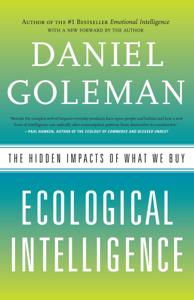
Want to learn the ideas in Ecological Intelligence better than ever? Read the world’s #1 book summary of Ecological Intelligence by Daniel Goleman here.
Read a brief 1-Page Summary or watch video summaries curated by our expert team. Note: this book guide is not affiliated with or endorsed by the publisher or author, and we always encourage you to purchase and read the full book.
Video Summaries of Ecological Intelligence
We’ve scoured the Internet for the very best videos on Ecological Intelligence, from high-quality videos summaries to interviews or commentary by Daniel Goleman.
1-Page Summary of Ecological Intelligence
Industrial Ecology: Measuring Products’ Effects on the Environment
“Ecological intelligence” is the awareness of how your actions impact the world around you. It includes learning about impacts on the geosphere, biosphere and sociosphere. This kind of intelligence can help you make better purchasing decisions because it makes you aware of what goes into making an item and how a company treats its employees.
Industrial ecology is a new field that looks at the effects of manufacturing on the environment. It covers multiple factors, including how much energy and materials are used to make a product, as well as what happens when it’s discarded. The biosphere outcomes for each product can be measured by looking at its resource burden and pollution caused during use. Other metrics include “biodegradability,” “cancer impact,” “loss of biodiversity,” and others such as “embedded toxicity” and “disability adjusted life years.”
Consumers need and want to know how their consumption impacts the environment. They want this information in an understandable metric that explains the effect of a product’s manufacture, use and disposal on the Earth. Such “radical transparency” would transform people’s purchasing decisions by connecting responsibility for a product’s impact to its popularity, thus incentivizing businesses to make changes. For example, if consumers knew how much CO2 was emitted during manufacturing they could vote with their wallets and force change. Consumers have been demanding such responsibility for years now.
Industrial ecology is a concept that helps us understand the environmental impact of products. It uses life cycle assessment to measure the harmful impacts of a product over its lifetime, which includes all the materials and processes involved in making it, using it and discarding it. For example, glass jars have many ecological interconnections. They are made by melting sand and caustic soda in 1,959 steps. Caustic soda requires sodium chloride (salt), limestone and other chemicals to make glass from melted sand; these chemicals require mining for their raw material; this process uses water, energy and transportation as well.
Mindful Shopping
Using the label “green” to sell products is a tactic known as greenwashing. It makes people think that the product is environmentally friendly without considering its overall impact on the environment. This can be harmful, since it perpetuates a lie that says by recycling or buying certain “relatively virtuous” products you are doing enough. However, this is not true because most consumer choices are harmful and limited from the outset. Consumers need more nontoxic choices, or at least a fuller understanding of their decisions’ environmental costs—and they’re not getting them yet.
Sunscreen ingredients are hurting coral reefs. People wash 4,000 to 6,000 metric tons of sunscreen into the ocean each year. This poses a risk of making 10% of coral reefs into bleached skeletons.
Because of global warming, snowfall is decreasing in many areas. As a result, ski resorts have to make more artificial snow. This requires lots of energy and contributes to the warming problem.
Shower curtains made from polyvinyl chloride are cheap, but they contain harmful chemicals and degrade poisonously. The danger of manufacturing such a curtain is also great, as it can cause many health problems for workers. Locally grown food might be more ecologically sound than other options, but there are still some issues to consider. For example, local foods may have been produced in places that aren’t environmentally friendly or safe for the people working there. It’s important to understand how interconnected everything is so we can make better decisions about our environment.





